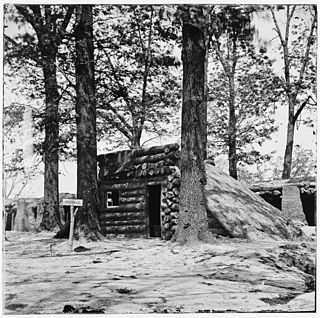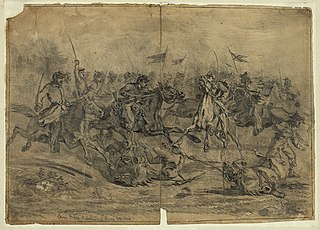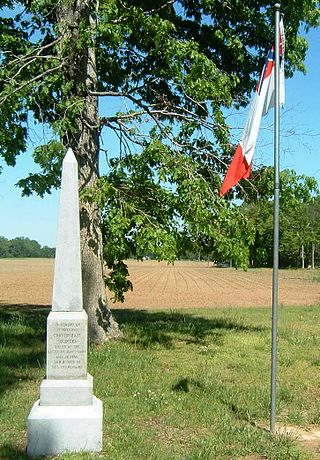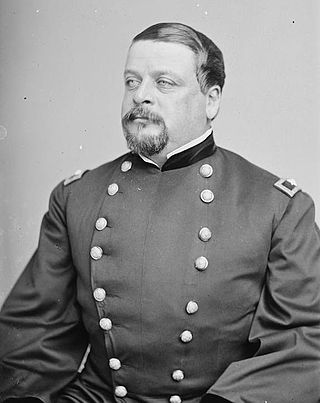
The Richmond–Petersburg campaign was a series of battles around Petersburg, Virginia, fought from June 9, 1864, to March 25, 1865, during the American Civil War. Although it is more popularly known as the siege of Petersburg, it was not a classic military siege, in which a city is encircled with fortifications blocking all routes of ingress and egress, nor was it strictly limited to actions against Petersburg. The campaign consisted of nine months of trench warfare in which Union forces commanded by Lt. Gen. Ulysses S. Grant assaulted Petersburg unsuccessfully and then constructed trench lines that eventually extended over 30 miles (48 km) from the eastern outskirts of Richmond, Virginia, to around the eastern and southern outskirts of Petersburg. Petersburg was crucial to the supply of Confederate Gen. Robert E. Lee's army and the Confederate capital of Richmond. Numerous raids were conducted and battles fought in attempts to cut off the Richmond and Petersburg Railroad. Many of these battles caused the lengthening of the trench lines.

The Battle of Fort Stedman, also known as the Battle of Hare's Hill, was fought on March 25, 1865, during the final weeks of the American Civil War. The Union Army fortification in the siege lines around Petersburg, Virginia, was attacked in a pre-dawn Confederate assault by troops led by Maj. Gen. John B. Gordon. The attack was the last serious attempt by Confederate troops to break the Siege of Petersburg. After an initial success, Gordon's men were driven back by Union troops of the IX Corps commanded by Maj. Gen. John G. Parke.

The Battle of Brandy Station, also called the Battle of Fleetwood Hill, was the largest predominantly cavalry engagement of the American Civil War, as well as the largest ever to take place on American soil. It was fought on June 9, 1863, around Brandy Station, Virginia, at the beginning of the Gettysburg Campaign by the Union cavalry under Maj. Gen. Alfred Pleasonton against Maj. Gen. J.E.B. Stuart's Confederate cavalry.

The Overland Campaign, also known as Grant's Overland Campaign and the Wilderness Campaign, was a series of battles fought in Virginia during May and June 1864, in the American Civil War. Lt. Gen. Ulysses S. Grant, general-in-chief of all Union armies, directed the actions of the Army of the Potomac, commanded by Maj. Gen. George G. Meade, and other forces against Confederate Gen. Robert E. Lee's Army of Northern Virginia. Although Grant suffered severe losses during the campaign, it was a strategic Union victory. It inflicted proportionately higher losses on Lee's army and maneuvered it into a siege at Richmond and Petersburg, Virginia, in just over eight weeks.

The Battle of Appomattox Court House, fought in Appomattox County, Virginia, on the morning of April 9, 1865, was one of the last battles of the American Civil War (1861–1865). It was the final engagement of Confederate General in Chief, Robert E. Lee, and his Army of Northern Virginia before they surrendered to the Union Army of the Potomac under the Commanding General of the United States Army, Ulysses S. Grant.

William Henry Fitzhugh Lee, known as Rooney Lee or W. H. F. Lee, was the second son of General Robert E. Lee and Mary Anna Custis. He was a planter, a Confederate cavalry General in the American Civil War, and later a Democratic Congressman from Virginia.

David McMurtrie Gregg was an American farmer, diplomat, and a Union cavalry general in the American Civil War.

The Battle of Sailor's Creek was fought on April 6, 1865, near Farmville, Virginia, as part of the Appomattox Campaign, near the end of the American Civil War. It was the last major engagement between the Confederate Army of Northern Virginia, commanded by General Robert E. Lee, and the Army of the Potomac, under the overall direction of Union General-in-Chief Lieutenant General Ulysses S. Grant.

The Appomattox campaign was a series of American Civil War battles fought March 29 – April 9, 1865, in Virginia that concluded with the surrender of Confederate General Robert E. Lee's Army of Northern Virginia to forces of the Union Army under the overall command of Lieutenant General Ulysses S. Grant, marking the effective end of the war.

The Battle of Haw's Shop or Enon Church was fought on May 28, 1864, in Hanover County, Virginia, as part of Union Lt. Gen. Ulysses S. Grant's Overland Campaign against Confederate Gen. Robert E. Lee's Army of Northern Virginia during the American Civil War.

The Battle of Trevilian Station was fought on June 11–12, 1864, in Union Lt. Gen. Ulysses S. Grant's Overland Campaign against Confederate Gen. Robert E. Lee's Army of Northern Virginia. Union cavalry under Maj. Gen. Philip Sheridan fought against Confederate cavalry under Maj. Gens. Wade Hampton and Fitzhugh Lee in the bloodiest and largest all-cavalry battle of the war.
The Battle of Saint Mary's Church was an American Civil War cavalry battle fought on June 24, 1864, as part of Union Lt. Gen. Ulysses S. Grant's Overland Campaign against Confederate Gen. Robert E. Lee's Army of Northern Virginia.

The Battle of Globe Tavern, also known as the Second Battle of the Weldon Railroad, fought August 18–21, 1864, south of Petersburg, Virginia, was the second attempt of the Union Army to sever the Weldon Railroad during the siege of Petersburg of the American Civil War. A Union force under Maj. Gen. Gouverneur K. Warren destroyed miles of track and withstood strong attacks from Confederate troops under Gen. P.G.T. Beauregard and Lt. Gen. A.P. Hill. It was the first Union victory in the Richmond–Petersburg Campaign. It forced the Confederates to carry their supplies 30 miles (48 km) by wagon to bypass the new Union lines that were extended farther to the south and west.

On the third day of the Battle of Gettysburg during the disastrous infantry assault nicknamed Pickett's Charge, there were two cavalry battles: one approximately three miles (5 km) to the east, in the area known today as East Cavalry Field, the other southwest of the [Big] Round Top mountain.
The Battle of Appomattox Station was fought between a Union Army cavalry division under the command of Brigadier General George Armstrong Custer and Confederate Army of Northern Virginia artillery units commanded by Brigadier General Lindsay Walker with support from some dismounted cavalrymen, artillerymen armed with muskets and some stragglers on April 8, 1865, at Appomattox Station, Virginia during the Appomattox Campaign of the American Civil War.
The Battle of Amelia Springs, Virginia was an engagement between the Union Army and Confederate Army of Northern Virginia that occurred on April 5, 1865 during the Appomattox Campaign of the American Civil War. It was followed by a second rear guard action near the same location on the night of April 5, 1865 and morning of April 6, 1865 during the Union Army pursuit of the Confederate forces which were fleeing westward after the fall of Petersburg and Richmond, Virginia at the Third Battle of Petersburg on April 2, 1865. The actions took place just prior to the Battle of Sailor's Creek on April 6, 1865. That battle would be the last major engagement between the Union Army under the overall direction of Union General-in-Chief, Lt. Gen. Ulysses S. Grant, and General Robert E. Lee's Army of Northern Virginia before that Confederate army's surrender at Appomattox Court House, Virginia on April 9, 1865.

The First Battle of Deep Bottom, also known as Darbytown, Strawberry Plains, New Market Road, or Gravel Hill, was fought July 27–29, 1864, at Deep Bottom in Henrico County, Virginia, as part of the Siege of Petersburg of the American Civil War. A Union force under Maj. Gens. Winfield S. Hancock and Philip H. Sheridan was sent on an expedition threatening Richmond, Virginia, and its railroads, intending to attract Confederate troops away from the Petersburg defensive line, in anticipation of the upcoming Battle of the Crater. The Union infantry and cavalry force was unable to break through the Confederate fortifications at Bailey's Creek and Fussell's Mill and was withdrawn, but it achieved its desired effect of momentarily reducing Confederate strength at Petersburg.

The Battle of Darbytown and New Market Roads was an engagement between Union and Confederate forces during the American Civil War, which took place on October 7, 1864, in Henrico County, Virginia, as part of the Richmond-Petersburg Campaign.

Alfred Gibbs was a career officer in the United States Army who served as a brigadier general in the Union Army during the American Civil War.

John Bratton was a U.S. Representative from South Carolina, as well as a general in the Confederate States Army during the American Civil War. He rose from private to brigadier general and led a regiment and brigade in the Army of Northern Virginia in several important battles in both the Eastern Theater and Western Theater during the war.
















